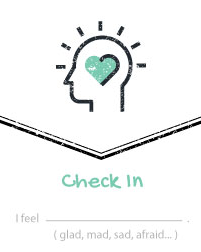 Last month we had a look at the ‘Pass/unpass’ core protocol, used to indicate whether you are actively engaged with your teammates in an activity. Today let’s go a bit deeper into what being actively engaged when you’re part of a high-performing team means by examining two more protocols: Check In and Check Out. They are related, but they’re not merely opposites of each other.
Last month we had a look at the ‘Pass/unpass’ core protocol, used to indicate whether you are actively engaged with your teammates in an activity. Today let’s go a bit deeper into what being actively engaged when you’re part of a high-performing team means by examining two more protocols: Check In and Check Out. They are related, but they’re not merely opposites of each other.
Checking In
When you’re in a psychologically safe team environment, you bring your whole self into that space: your emotions, your thoughts, your distractions, and your physical state. We are complex chaotic humans, with all the baggage that entails.
You bring all that stuff to work with you, but on many teams, it isn’t acknowledged. You may be expected to leave most of yourself at the door, only presenting the work-related thoughts and feelings. This ignores the impact that each person’s contextual stuff has on the team’s effectiveness and on the work itself.
The Check In protocol is a way to begin meetings or conversations by acknowledging your present state and sharing it with each other, in a simple declaration.
The team agreements that accompany Check In consist of:
- Stating your feelings without qualification – you don’t need to justify or account for your state of mind. You can offer a brief explanation if you choose, in case it might be significant, or there’s important information the rest of the group is unaware of, but there’s no requirement to do so. Nor should you diminish your emotions by using negative qualifiers, like saying you’re “a little bit sad.”
- Talking only about your own feelings – it’s not a moment to reflect or interpret or relate to anyone else present, or how anyone has “made” you feel…
- Listening respectfully while others are Checking In
- Not discussing or referring to another person’s Check In, unless invited to do so or given explicit permission
Under the Core Protocols, a Check In is short and sweet, because you express all emotions in terms using the four primary emotions: GLAD, SAD, MAD, and AFRAID.
This deceptively simple framework enables you to reflect and understand your feelings enough to map them to these four primary emotions. (You may substitute Happy for Glad, or Scared for Afraid, without altering the meanings.)
By combining these primary emotions, you can express more complex states. For example, excitement may be a combination of Glad and Afraid, or feelings of loss being a mix of Anger and Sadness. With a little forethought you can check in profoundly with just these four words, and it provides an instant update for your colleagues. In Check In “by the book”, we conclude with the phrase “I’m in”.
In many teams familiar with and using the Core Protocols, it’s habitual for everyone to Check In if one person does so. This is how high-performing teams stay up-to-date with everyone’s present state: they frequently and immediately perform a temperature-check of the team. With some practice, it can be done very quickly, even in a large group.
So that’s Checking In. What about Checking Out?
Check Out and go…
The Check Out protocol is an extension of the Pass option we discussed previously. Sometimes opting-out of a specific question or activity just isn’t enough.
In high-performance teams, the physical presence of a team member signifies that they’re engaged and ready to contribute optimally. So the corollary expectation is, when this does not apply, you physically depart from the team space.
No need for explanation, drama, or disruption. Just state “I’m checking out” and head for the door. Leave the room and everything going on in it until you’re ready to show up and return – then you Check In, briefly and without fuss, to signify your readiness to be back on it.
The idea is to protect the effectiveness of the team by ensuring everyone present is fully on their game and ready to contribute (even if they’ve Checked In with some “negative” emotions). If anyone is past the point of contributing effectively (or becomes that way at any point), it’s better they’re not around.
Checking Out is not “flouncing out” – you just exit, clearly but quietly, with dignity and lack of disruption. It might be appropriate to indicate an anticipated return time if known. If not, just leave, until you’re ready to return and keep the Core Commitments with your teammates.
In return, they won’t follow you, question you, hassle, judge, or shame you for this action, or discuss the reasons either while you’re out or when you return. They’ll just get on with the work, safe in the knowledge that those still in the room are engaged, receptive, and ready to collaborate and efficiently contribute.
Isn’t that better than trying to work with people who are physically present – but where everything about their body language, effort, or attention is signifying that their hearts and minds could not be further from the activity in hand? Haven’t we all been in one of those awful conversations? In a team of functioning and self-aware adults, it just isn’t necessary.
Try experimenting with these two complementary protocols and see for yourself. Let me know how this freedom to choose impacts the performance of your team.





